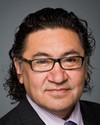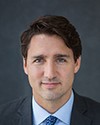Mr. Speaker, I would like to begin by recognizing that we are, as we are every day in the House, on the ancestral land of the Algonquin people.
Last September, I spoke before delegations from all over the world at the United Nations. I told them the harsh truths about the long and complex relationship that Canada has with first nations, the Inuit, and the Métis nation. I spoke about the colonial approach that led to the Indian Act, which is discriminatory and paternalistic.
It was a colonial approach that systematically ignored the history of the Métis nation and denied its people their rights and that in the name of Canadian sovereignty, forced the relocation of entire Inuit communities, starving individuals, uprooting families, and causing generations of harm.
I am sure that all members of the House are very familiar with these tragic events, but it is remarkable how much Canadians know about them.
I just finished a series of town hall visits in communities all across Canada. Everywhere I went, there was at least one person who wanted to know what our government is doing to combat racism, to help advance reconciliation, to improve the quality of life for indigenous peoples. There were questions about fishing rights, land claims, and pipeline approvals, questions about the national inquiry into missing and murdered indigenous women and girls, about clean water, and about the alarming number of indigenous children in foster care.
These were thoughtful questions, and it was immediately clear, every time these kinds of questions were asked, that the room leaned in to hear. This was, in part, a show of support for the people who stood up and asked some tough questions, but it was also a signal that these are questions that Canadians want answered, questions that strike right at the heart of who we are and what kind of country we want to be.
One of those questions is how we, as a government, recognize and implement the rights of indigenous peoples. We have seen those questions grow in number and intensity in just these past few days, as more and more Canadians come to grips with the fact that we have so much more work to do, more work to push back against the systemic racism that is the lived reality for so many indigenous peoples, more work to deal with the fact that too many feel and fear that our country and its institutions will never deliver the fairness, justice, and real reconciliation that indigenous peoples deserve.
There is also reason to be hopeful. Yesterday I had the honour of spending some time with Colten Boushie's family, with his mom, Debbie; cousin, Jade; and Uncle Alvin. Through all their grief and anger, and frustration, their focus was not on themselves and the tragedy they just endured, but on how we must work together to make the system and our institutions better, better for indigenous youth, for indigenous families, and for all Canadians.
We have a responsibility to do better, to be better, to do our best to make sure that no family has to endure what they went through.
The criminal justice system is just one place in which reforms are urgently needed. Reforms are needed to ensure that, among other things, indigenous peoples might once again have confidence in a system that has failed them all too often in the past. That is why we will bring forward broad-based concrete reforms to the criminal justice system, including changes to how juries are selected.
Obviously, indigenous peoples and all Canadians know that change is way overdue.
At the same time, some see our government's ambitious commitments with a certain degree of distrust. If we look at how things have been done in the past, it is difficult to honestly say that such distrust is not warranted.
After all, it is not as though we are the first government to recognize the need to make changes and to promise to do things differently.
Over 20 years have passed since the Royal Commission on Aboriginal Peoples called for the recognition of indigenous people as self-governing nations with a unique place in Canada. Over 30 years have passed since the Penner report and the first ministers’ conferences on the rights of aboriginal peoples.
Last year marked 35 years since aboriginal and treaty rights were recognized and affirmed through section 35 of the Constitution Act. The government of the day, led by my father, did not intend to include these rights at the outset. It was the outspoken advocacy of first nations, Inuit, and Métis peoples, supported by non-indigenous Canadians, that forced that government to reconsider.
Imagine what that must have felt like, to have fought so long, so hard, against colonialism, rallying their communities, reaching out to Canadians, riding the Constitution express, and in the end, to finally be recognized and included, to see their rights enshrined and protected in the foundational document upon which Canada's democracy rests.
Now, imagine the mounting disappointment, the all too unsurprising and familiar heartache, and the rising tide of anger when governments that had promised so much did so little to keep their word.
The challenge then, as now, is that while section 35 recognizes and affirms aboriginal and treaty rights, those rights have not been implemented by our governments. The work to give life to section 35 was supposed to be done together with first nations, Inuit, and Métis peoples, and while there has been some success, progress has not been sustained nor significant. Therefore, over time it too often fell to the courts to pick up the pieces and fill in the gaps. More precisely, instead of outright recognizing and affirming indigenous rights, as we promised we would, indigenous peoples were forced to prove time and time again, through costly and drawn out court challenges that their rights existed and must be recognized and implemented.
Indigenous peoples, like all Canadians, know that this must change, and we know this too. That is why we have been working hard for two years to renew our relationship with indigenous peoples, a relationship based on recognition of rights, respect, co-operation, and partnership. We are on the right track.
We endorsed the United Nations Declaration on the Rights of Indigenous Peoples without qualification and committed to its full implementation, including with government support for Bill C-262.
We engaged in new recognition of rights and self-determination negotiations, where the government and indigenous peoples work together on the priorities indigenous partners say are necessary to advance their vision of self-determination.
We signed agreements with first nations, Inuit, and the Métis nation, outlining how we will work together to identify each community's distinct priorities and how we will work together to develop solutions.
We established a working group of ministers to review our federal laws, policies, and operational practices to ensure the crown is meeting its constitutional obligations and adhering to international human rights standards, including the UN Declaration on the Rights of Indigenous Peoples.
To guide the work of decolonizing Canadian laws and policies, we adopted principles respecting Canada's relationship with indigenous peoples.
To preserve, protect, and revitalize indigenous languages, we are working jointly with indigenous partners to develop a First Nations, Inuit, and Métis languages act. We have made changes in order to recognize indigenous rights and traditional knowledge, as well as to make sure that indigenous peoples are more included when there are developments in their communities.
These efforts are an important start, but they are just a start. To truly renew the relationship between Canada and indigenous peoples, not just for today but for the next 150 years and beyond, we need a comprehensive and far-reaching approach. We need a government-wide shift in how we do things. We need to both recognize and implement indigenous rights, because the truth is, until we get this part right, we will not have lasting success on the concrete outcomes that we know mean so much to everyone.
Indigenous peoples in Canada should be able to drink the water that comes out of their taps. They should be able to go to sleep in homes that are safe and not overcrowded. Indigenous children should be able to stay with their families and communities where they are known and loved. Indigenous youth should not grow up surrounded by the things that place them at elevated risk for suicide, such as poverty, abuse, and limited access to a good education and good health care.
All of these things demand real, positive action, action that must include and be grounded in the full recognition and implementation of indigenous rights. We need to get to a place where indigenous peoples in Canada are in control of their own destinies and making their own decisions about their futures.
Today, I am pleased to announce that the government will develop, in full partnership with first nations, Inuit, and Métis people, a new recognition and implementation of indigenous rights framework that will include new ways to recognize and implement indigenous rights. This will include new recognition and implementation of rights legislation. Going forward, recognition of rights will guide all government interactions with indigenous peoples. The contents of the framework that we build together will be determined through a national engagement led by the Minister of Crown-Indigenous Relations and Northern Affairs with support from the Minister of Justice.
Earlier, I cited many reports and a number of previous studies and consultations. I can appreciate that some would see any future consultation as just another hindrance to the struggle for the self-determination of indigenous people. Let us be clear: no matter how responsible, well-intentioned, or thoughtful it is, a solution coming just straight out of Ottawa will not do much good.
We understand that indigenous peoples are looking forward to beginning the considerable work themselves to rebuild their nations and their institutions. As a government, our work is to support First Nations, Inuit, and Métis peoples and to work in partnership with them to establish the framework and provide them with the tools they need as they lead the way, together with all Canadians.
We will also be engaging the provinces and territories, non-indigenous Canadians, people from civil society, industry, and the business community, and the public at large, because all Canadians have a stake in getting this right. While the results of this engagement will guide what the final framework looks like, we believe that, as a starting point, it should include new legislation and policy that would make the recognition and implementation of rights the basis for all relations between indigenous peoples and the federal government moving forward.
This framework gives us the opportunity to build new mechanisms to recognize indigenous governments and ensure the rigorous, full, and meaningful implementation of treaties and other agreements. With this framework, we have a chance to develop new tools to support the rebuilding of indigenous communities, nations, and governments, and advance self-determination, including the inherent right of self-government.
This framework could establish new ways to resolve disputes so that collaboration becomes the new standard and conflict the exception rather than the rule. By including tools that oblige the federal government to be more transparent and accountable, we can build greater trust between indigenous peoples and government.
Lastly, with this new framework, we will be able to better align Canadian legislation and policies with the United Nations Declaration on the Rights of Indigenous Peoples, which the government wholeheartedly supports.
We believe that a framework that includes measures such as this one will finally act on many of the recommendations made by the Royal Commission on Aboriginal Peoples and the Truth and Reconciliation Commission of Canada and set out in countless other studies and reports over the years.
Some may worry that this ambitious approach may require reopening the Constitution. That is not true. In fact, we are finally fully embracing and giving life to the existing section 35 of the Constitution. We will replace policies like the comprehensive land claims policy and the inherent right to self-government policy with new and better approaches that respect the distinctions between first nations, Inuit, and Métis peoples. This will give greater confidence and certainty to everyone involved.
The federal government's absence over generations in recognizing and implementing indigenous rights has resulted in social and economic exclusion, uncertainty, and litigation, when our shared focus should have always been on creating prosperity and opportunity for everyone. Better opportunities for indigenous peoples and certainty for indigenous youth are precisely what we hope to achieve through this framework.
Engagement will continue throughout the spring, but it is our firm intention to have the framework introduced later this year and implemented before the next election.
This is work not only for the government, but for this Parliament as well. There will be committee work, witnesses, and vigorous debate in both chambers.
The history of Canada’s relationship with indigenous peoples transcends all governments. The Indian Act was passed in this House, as was section 35. Now, as a Parliament, we have the opportunity, and in fact the responsibility, to finally implement section 35.
We all know that we cannot erase the past. We cannot recover what was lost. What we can do, what we must do, is to commit to being better and doing better. As a start, let us do what the Constitution Act, 1982, has required us to do for almost 40 years.
We will work together to do away with legislation and policies built to serve colonial interests. We will work together as we follow through on our commitments to build a new and better relationship.
Indigenous Canadians and all Canadians are ready for change, ready for a new relationship based on recognition, rights, respect, co-operation, and partnership. With a recognition and implementation of rights framework, we can build that new relationship together. It will not be easy, nothing worth doing ever is, but it will be worth it. It will be worth it because we will have taken more steps toward righting historical wrongs. It will be worth it because we will have replaced apathy with action, ignorance with understanding, and conflict with respect. We will have laid the foundation for real and lasting change, the kind of change that can only come when we fully recognize and implement indigenous rights.
Together we will take concrete action to build a better future, a better Canada, for indigenous peoples and for all Canadians.














